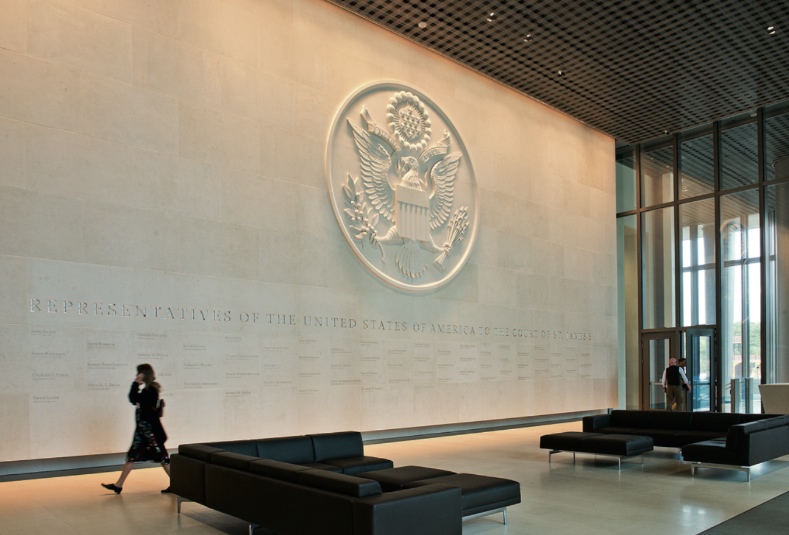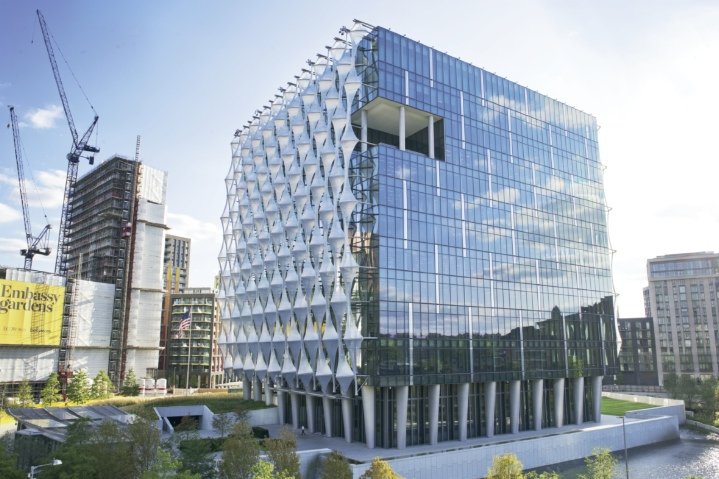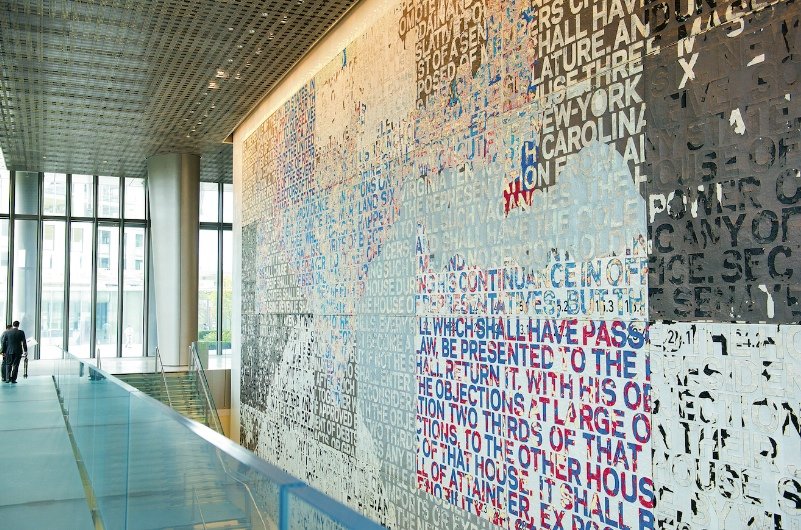The US Embassy is throwing its doors open to the general public for the first time as part of Open House London this weekend

Few Londoners can have failed to notice that there’s a new United States Embassy in town.
Firstly, it’s hard to miss. The enormous glass cube is currently the most striking landmark in Nine Elms, a post-industrial stretch of riverbank that’s still very much a work in progress. Those who don’t visit Wandsworth very often may still have heard the President of the United States criticising it on the news.
Branding the development a ‘bad deal’, he said he refused to cut the ribbon on the new embassy when it opened in January because the Obama administration had sold the old Mayfair one for ‘peanuts’ to move to an ‘off-location’ (in fact, it was George W Bush’s administration that sold it).
“What are we to take seriously of what the President says at this point?”, says an exasperated James Timberlake, from KieranTimberlake, the American architecture firm behind the project. “If you have any doubts about whether it’s a good move or not, just ask the staffers in the building and the ambassador; he thinks it’s brilliant and he loves the building.”
They’re so confident in the final result that they’ve decided to let the public pass judgement for themselves for the Open House London event. The annual showcase sees more than 800 buildings that are either under construction or usually closed to the public throw open their doors to visitors for two days only.
The Department of State, aware of the reputation its embassies have for being fortress-like compounds, sought a modern beacon that radiated US values of transparency and openness
“It represents what this new embassy is about,” says Andrew Veveiros, a US Embassy spokesperson, who gave me a sneak preview of what’s in store for the 75 ballot winners.
It’s the first time the US Embassy has moved from its former Grosvenor Square home in 200 years. Unusually, the freehold of the building isn’t owned by the US government, but by the Duke of Westminster, who reportedly would only sell if they returned the land confiscated from his family during the American War of Independence.
Unsurprisingly, the US government decided to lease it instead, but began to look for a new home once the last one became overcrowded and failed to meet post-9/11 security demands.
An architectural competition was launched – only the third in history for a US embassy – to find an American firm willing to design a new home for the US in London from scratch. In total, 38 firms submitted, which were whittled down to four, who were invited to spend a week in London to learn about the new location and get their heads around a very complicated brief.

The new embassy from the outside. Photo: Greg Sigston
“Printed out on single-sided paper, it was about 480 pages,” says Timberlake. “It was detailed right down to the size of certain rooms and the furniture that would go into them.” The jury convened in Washington in early 2010 and handed KieranTimberlake its first embassy project.
By this point, the US government had already acquired the new site in Nine Elms, funded entirely by the sale of its other properties in London. “It’s a pretty brilliant real estate move on the part of the US government, frankly,” says Stephen Kieran, the other half of KieranTimberlake.
The Department of State, aware of the reputation its embassies have for being fortress-like compounds, sought a modern beacon that radiated US values of transparency and openness. That’s where all the glass came from, and the extensive landscaping.
“The security requirements at all levels became a real impetus to creativity,” says Kieran. “We implemented landscape ideas that made the building secure, but when you look at them, you wouldn’t necessarily see them as security, you’d see them as part of the urban landscape.”

Former ambassador Matthew Barzun's portrait. Photo: Greg Sigston
This includes a curved wall with benches built into it on the south side of a new plaza, and the now famous pond separating the entrance from the road. Though it has been called a moat, it doesn’t surround the building and you’d rob staffers of the opportunity to joke about being ‘across the Pond.’
Gardens are also a vital part of the infrastructure, spiralling up the building, providing breakout spaces and social hubs for staffers and visitors alike. Many of them are designed to resemble famous American landscapes, with redwood sculptures and native plant species. The ambassador even has his own garden, a characteristic of many US embassies; the Potomac Garden leading to his suite is meant to be “a hint of Washington DC” in Vauxhall.
While Open House visitors won’t be allowed into the ambassador’s private offices, they will get to see some of the impressive artwork adorning the walls of the ground and lower floors. Specially commissioned from a mix of British and American artists, the embassy has a full-time art curator on site.

We The People artwork by Mark Bradford. Photo: Greg Sigston
Highlights include a Sean Scully mosaic on the way in and a huge flatpack concrete cast of a typical American suburban house, complete with US plug sockets and light switches, created by British artist Rachel Whiteread, which straddles a turnstile entrance.
Leading down to a flexible lecture/conference space is “We the People” by Mark Bradford, a series of 32 wall panels that spell out the US Constitution with found materials, cleverly concealing outlines of American landmarks and states.
UK Ambassadors are on three year assignments and get to choose an artist to paint their portrait when their term is up. The results are lined up on the lower ground floor and each says something about the era they presided over, especially Matthew Barzun’s gleaming, minimalist masterpiece.
One thing is missing though. The famous golden eagle that crowned the old embassy had to be left behind as it’s part of the building’s heritage listing. “We’ll have to make new icons here,” says Veveiros.
Open House London runs from 22-23 September 2018. Visit openhouselondon.org to find out more.